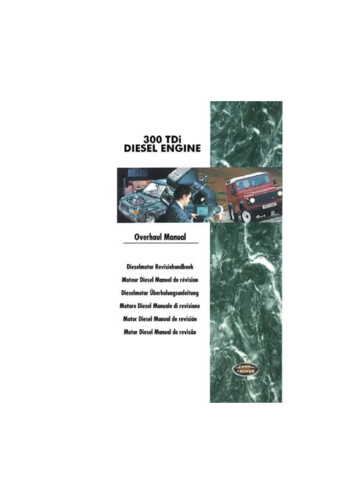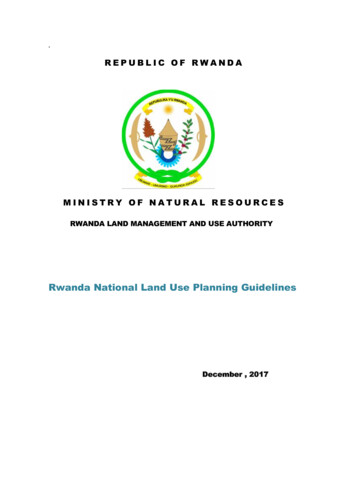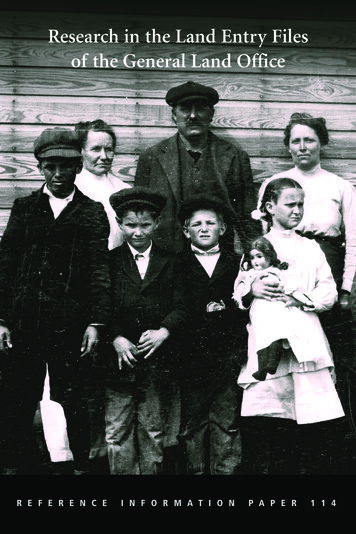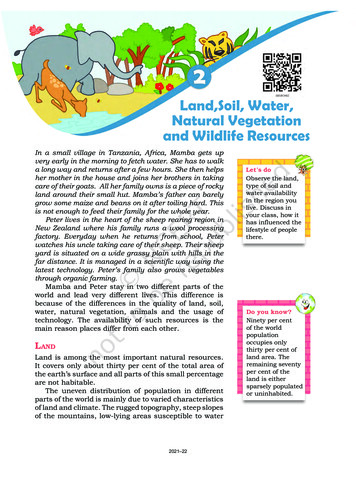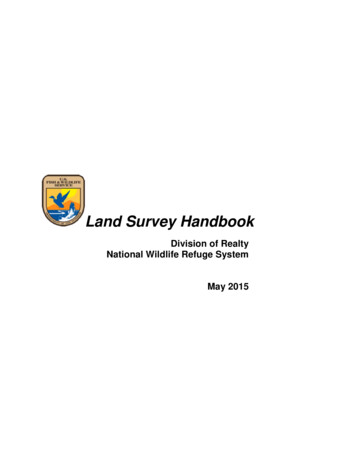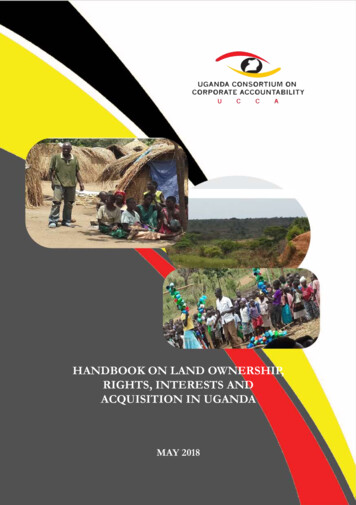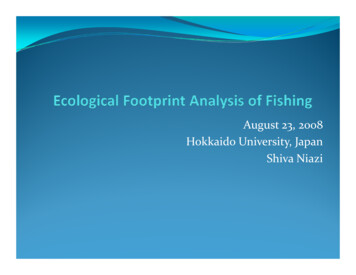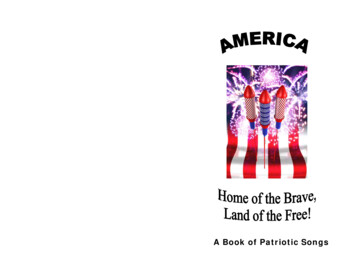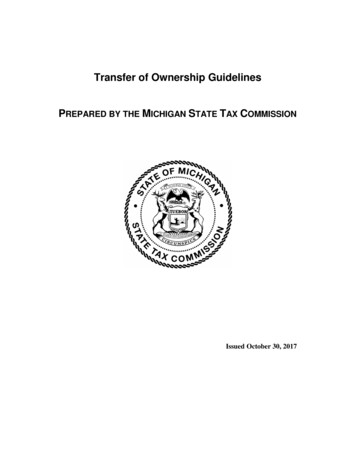
Transcription
Introduction to Land Use PlanningWorkshop 1: Land Use and TransportationM2D2 – Multi Modal Development and DeliveryMarch 10, 20151
Agenda Purpose of Planning History and LegalContext Types of Plans Relationship betweenLand Use andTransportation Plans Placemaking2
“Trend is notdestiny.”-LewisMumford3
Why plan?“The best way topredict the future is toinvent it.”- Immanuel Kant4
Why plan?“By failing to prepare,you are preparing tofail.”-Benjamin Franklin5
Why plan?“Have a plan. Follow theplan and you’ll be surprisedhow successful you can be.Most people don’t have aplan. That’s why it is easy tobeat most folks.”- Paul “Bear” Bryant6
Why plan? Respond to an evolving marketCatalyze economic and fiscalhealthProvide housing andtransportation choiceMake efficient use ofinfrastructurePreserve open spaceProtect critical environmentalareas and sensitive landReduce urban runoffReduce vehicle miles traveled7
Why Plan? Good plans shapegood decisions Money follows plans Required8
Daily Benefits of PlanningThe daily commuteThe work placeA place to recreateA place to relaxA safe and affordablelifestyle An opportunity toshape the community Confidence in thefuture 9
Current Planning Issues al EquityEconomy ronmentHealthFood Recovery– Energy– Transportation– Housing Climate Change– Energy– Transportation– Food10
History and legal basis for planning Planning and Zoning activities are allowed understate and federal constitutions as an exercise of“police power,” i.e., local government’s responsibilityto protect the health, safety and welfare of itscitizens. Early zoning ordinances – involving separation ofuses – first occurred in urban areas like New YorkCity, San Francisco, and Chicago, in the 1890s andearly 1900s, in response to tenement slumconditions and close proximity of industry next toresidential areas – spread of tuberculosis, influenza,dysentery, as well as spread of crime, were rampant.11
History and legal basis for planning 1924 – basic concept ofzoning was challengedin Amber Realty vs. Cityof Euclid, OH –“Euclidian Zoning”, ordividing City into zoningdistricts. SupremeCourt upheld Euclid’sright to segregate usesas a means to protectpublic health, safety,and welfareNa#onalCleveland- ‐StylePolkaHallofFameEuclid,OH12
History and legal basis for planning Standard Zoning Enabling Act – 1925. Promulgatedby U.S. Department of Commerce during HerbertHoover administration. Viewed as a means toprotect the interests of business as well asresidents. Provided model language for zoningordinances. Standard Enabling Planning Act followed, also out ofDepartment of Commerce. Set forth that zoning andland use regulations should not be ad-hoc decisions,but instead should be based on comprehensiveplanning goals and objectives arrived atdemocratically.13
History and legal basis for planning Zoning has evolved to where now we can regulatesignage, zone for aesthetics (design review programs),and impose landscape requirements on developments,all in an effort to protect public health, safety and welfare. Due Process – no plan or zoning regulation can beadopted without adequate and meaningful opportunityfor public involvement. Equal Protection – Nobody gets preferential treatmentunder a legitimate regulatory program. Regulatory Takings – Occurs when “all economic use ofa property has been removed as a result of theimposition of a regulation. Also called “inversecondemnation.”14
The Future of Planning Changingdemographics Changing lifestyles Disaster mitigation Transportationchoices Housing choices Energy conservation Green infrastructure15
Types of plans Land use plans Transportation plans Economic developmentplans Housing needsassessments Emergency response plans Park and recreation plans Open space plans Village plans/downtownplans Neighborhood plans16
Regional strategiesFrom “RegionalPlanning for aSustainable America”edited by Carlton K.Montgomery, RutgersUniversity Press, 2011www.regionalplans.org17
Growth management maps Map growth andconservation zones Framework for localplanning/zoning Mandatory vs.voluntary18
MerwinkeLaUrban growth boundariesRSalmonCree117THSturgeonLakeWASHINGTON CO.MULTNOMAH CO.ekRDI-5AVEAVEMtTalbertJohnsonCityYSIDE50 0HWYDamascusRDBoringDRH W Y 2 1 2 -2 2 4224HWClackam a PRDRDI11The information on this map was derived from digital databases on Metro's GIS. Carewas taken in the creation of this map. Metro cannot accept any responsibility forerrors, omissions, or positional accuracy. There are no warranties, expressed or implied,including the warranty of merchantability or fitness for a particular purpose,accompanying this product. However, notification of any errors will be appreciated.RDKREECRCRINTE RERHE NRIWAGAVMcIverPark0I-5DR iver0.512MilesEstacada213BeaverCreekClark Co.Y121HWYHWYCanbyHWlla Rivero laCLACKAMAS CO.MARION CO.99EMBarlowWashington Co. Multnomah Co.Clackamas Co.Location MapAuroraPlease recycle with mixed paperKRDMETRO DATA RESOURCE CENTER600 NORTHEAST GRAND AVENUE PORTLAND, OREGON 97232-2736TEL (503) 797-1742 FAX (503) 797-1909drc@metro.dst.or.us www.metro-region.orgEMARQUAM CANBY RDMulinoBARLOW RDYAMHILL CO.CLACKAMAS UNN4DMULTNOMAH CO.CLACKAMAS CO.BEWillamette182NDAVE39TH22RC r e ektns MWilsonvilleverYWASHINGTON CO.CO.BOONESLAtePeNewbergRi4STAF RDGreshamGladstoneRiverBOinSandy22T U AL A T I N - S H E R WtaMBLUCOSpringdaleSTARK geHWuRDF E RRRI-405DRRYERBOSReed atinMHWY 14MA R INEDHWY 212VDBLHWHWY4RDR I VERI-5LakeOswegoFHWDurhamBLVI-205O7HILLSBO ParkMilwaukieTigardUGhCamasRIEOSHOL LSchollseSANDJohnsonLLFE R R YSChYMc L OWASHINGTON CO.YAMHILL CO.AKCHARDBALDHWIslandFOSTERA VEPELaurelwoodDYMDARDHWCACooperMtnFarmingtonI LLRKBLVDMARDE LL99EMEBLVDG HI L L LHWYNRIMFARNTOP OWN RDCA N YBEAVERTONVDYPortlandOHWYAlohaSPV99EPA S ESB A RNHWR i v erNDSARDC O R N E LLAVECO RN E L I U Seklat i nIS &GovernmentWAYHWY47YHWNEHALE M30reTu aRTSC8POSTBLCORNELL galkerkYWest UnionBAW SHINGTONOREGONe ttreLOMmamoi ryNSVancouverSmithCOLakeBL LUMVD BIAWillFDaSUCorneliusYLEIslandcaekHelvetiaCounty LinesLaC reW . F o rkkUrban Growth BoundaryCreK6ForestGroveALdenS Y S T E MLegendAVEMcBridgeHayNorthPlainseCr e50 0HW Y082NDekHWYleseTONBurlingtonBanksHWYHWGa5I-20C reERlneanChiryDaWILSONR IV50S A type of growthmanagement map Limits growth outsideof identified urbanareas Requires ongoingplanning andimplementation to besuccessfulI N F O R M A T I O NMay 12, 2006OrchardsIslandH WYay26LakeahrkFoKillinWetlandsMul t n omE.USVancouverIL A N DUrban GrowthBoundaryHW YSauvieBuxtonLR E G I O N A Lk503COLUMBIA CO.MULTNOMAH CO.MULTNOMCLAR AH CO.K CO.ScappooseBE A VRRCEE19
Tax revenue sharing Eliminates ormitigates localcompetition for taxrevenue that leads tosprawl Extremely difficult toimplement20
Transfer of development rights Mechanism forpreserving openspace as a price ofdevelopment Supply and demandkey to success21
Controls on development of resource lands Identification andmapping of criticallands Identification ofcritical habitats Protection throughzoning anddevelopmentregulations22
Land and development rights acquisition Land Acquisition Conservationeasement Water trusts23
Innovative regionalinfrastructure planning Link land use andinfrastructure Scenario planning Proactive approachto development“subsidy”24
Water resource planning Water supply Water quality Clean up water bymanaging land use Federal mandate25
Sustainable community design policies Design reviewDark sky regulationsMixed use requirementsProfessional officelimitationsFormula businessrestrictionsBuilding footprintlimitationsShopping center squarefootage limitationsDrive-up limitationsAffordable housing26
Inclusive public engagementIf you don’t dothings with people,they assume youare doing things tothem.27
Relationship between land use andtransportation plans – Placemaking28
Traditional approach Transportation systemsprioritize high speedmobility Auto orienteddevelopment follows All other modes atdisadvantage Spread out developmentincreases transportationdemand Cycle ngThroughPlacemakingbyGaryToth29
Placemaking Access rather than mobility Urban streets as places ofsocial and economicexchange Non-motorized transportationis key to urban cores Neighborhood streets safefor play Commercial streets safe forwalking and cycling whilemoving through and localtraffic Plan for people and places,not cars and ngThroughPlacemakingbyGaryToth30
Placemaking“Transportation – theprocess of going to aplace – can be wonderfulif we rethink the idea oftransportation itself. Wemust remember thattransportation is thejourney, but enhancingthe community is alwaysthe ingThroughPlacemakingbyGaryToth31
Reduce Infrastructure Costs“the application of smart growth strategies overthe next 25 years could save as much as 250billion, mainly in the form of infrastructureinvestment.”Federal Reserve Vice Chairman of the Board ofGovernors, Edward GramlichSavings of:– 12% on road-building– 6% on water and sewer– 4 % on annual operations32Smart Growth is Smart Business, NALGEP & SGLI
Smart growth improves fiscal outcomesNJ study shows that by2020, a compact planproduces savings overthe business-as-usualplan:– Local governments cutannual fiscal deficit bynearly 40%– 870 million less in localroad infrastructure costs– 1.45 BILLION lessstatewide in sewer andother infrastructureThe Costs and Benefits of Alternative GrowthPatterns (NJ) 2000
Smart growth strategies bolster economicoutcomesArlingtonCounty,VA: 44.5millionsquarefeetofofficespaceCounty- ‐wide 41millionsquarefeet(92%)inMetrosta#onareas %oflandarea scorridorusetransittogettoworkFrom Dennis Leach, www.reconnectingamerica.org. 200334
Annual tax revenues generated fromthis area went from 400K beforeredevelopment (1995) to over 10million after redevelopment (2003).
Portlandsaves withbe ertransporta#onpoliciesSource: Joe Cortright, Portland’s Green Dividend,CEO for Cities, July 2007.36
Sacramento ngsforsmartgrowthvs.basecasescenario. martgrowthscenario.37
nthena#onaleconomywasover 1.2billion arningscomparedwithcoun#eswithouttransit38
Review Purpose of Planning History and LegalContext Types of Plans Relationship betweenLand Use andTransportation Plans Placemaking39
Mul l#plemodes.www.smartgrowthamerica.org
Introduction to Land Use Planning Workshop 1: Land Use and Transportation M2D2 – Multi Modal
